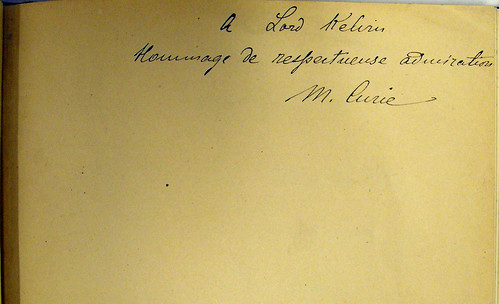Marie Curie
Marie Curie: Thèses présentées à la Faculté des Sciences de Paris pour obtenir le grade de Docteur es Sciences Physiques.
Paris: Gauthier-Villars, 1903
Sp Coll q103This published version of her doctoral thesis was presented by its author, Madame Curie, to the distinguished Glasgow physicist, Lord Kelvin, and is inscribed and signed on the flyleaf. (For more information about Lord Kelvin, see our web exhibition, William Thomson, Lord Kelvin).
Marie Sklodowska Curie (1867-1934) was a Polish-French physicist and chemist. A pioneer in radioactivity, the first two-time Nobel laureate (the only one in two different sciences), she was also the first female professor at the Sorbonne. She was born in Warsaw, Poland, where she lived until 1891 when she moved to Paris to study science. She obtained higher degrees and conducted almost all her scientific work in Paris and became a naturalized French citizen. She became the first female professor at the Sorbonne and in 1893 was the first woman in France to complete a doctorate with this thesis.
Marie had an amazing memory and a strong work ethic, neglecting food and sleep while studying. At the Sorbonne, she met and married Pierre Curie, a fellow instructor. Together they worked on radioactive substances and identified two new elements, naming them "polonium" and "radium". In 1903, Pierre and Marie Curie received the Nobel Prize in Physics, along with Henri Becquerel. Curie was the first woman to receive the Nobel Prize. In 1911, she also received the Nobel Prize in Chemistry. Unusually, she did not patent the radium-isolation process, allowing the scientific community to do research unhindered.
During World War I, she arranged the use of mobile radiography units for the treatment of wounded soldiers. In 1921 she toured the USA to raise funds for research on radium. In later years, she was disappointed by many physicians and makers of cosmetics who used radioactive materials without precautions. She died in 1934 from aplastic anaemia, almost certainly due to massive exposure to radiation, since much of her early work was undertaken without protection due to lack of knowledge of the damaging effects.

Image: Inscription and autograph of Marie Curie in Thèses présentées à la Faculté des Sciences...
This is the final book in the exhibition. Return to the Provenance exhibition homepage or go to: Sources used and further reading.


